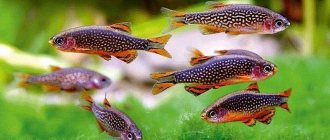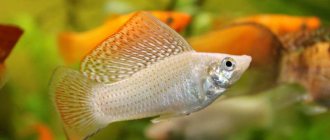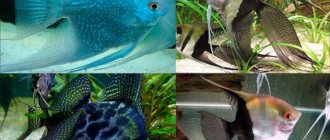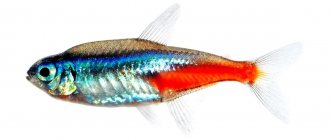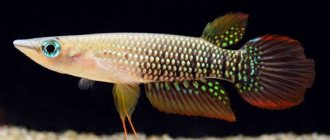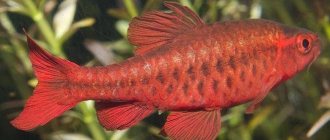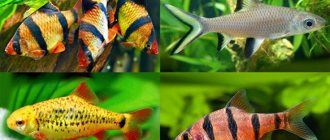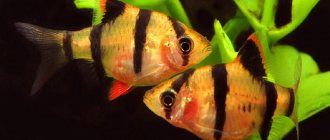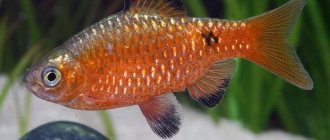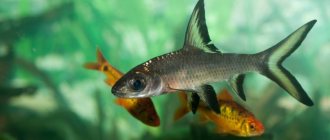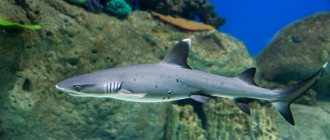Description
Scarlet Barbus (Puntius) is a representative of the Carp family of the Barbus genus. It also has other names - scarlet Odessa barb or tikto barb. The natural habitat of the species is the Republic of Myanmar, India, Thailand, the Himalayas, their surrounding creeks, lakes and small rivers. Although the puntius is not considered a bottom fish, it still spends a significant part of its time digging the muddy bottom in search of food.
Appearance
The body is elongated and laterally flattened. The head is triangular and pointed towards the end. The scales are large and clearly visible, the scales are painted silver. The belly of the fish is painted in light beige tones, the back is green-gray, and the color of the sides is gray-metallic. On the sides there are two black spots on each side - near the gills and at the caudal fin. A distinctive feature is a red-scarlet stripe running from head to tail. The fins have pronounced black elongated spots.
The size of the fish is small, in natural conditions 6–8 cm, but with involuntary breeding, representatives grow much smaller—3–5 cm.
Behavior
In aquariums it lives in the upper or middle layers of water. The character is peaceful and does not show much aggression towards other inhabitants. It leads a very active and mobile lifestyle, so it needs a large aquarium.
The Odessa barb is a schooling fish, so keeping them alone leads to poor health and illness of the fish. In nature, they live in schools of several dozen to hundreds of fish. Add at least 5-6 scarlet barb fish to the aquarium.
Scarlet barbs in their natural environment
The homeland of representatives of this species is Southeast Asia, where they are found over a fairly vast territory - from the Himalayan to Thai reservoirs. You can also find scarlet barbs in Bangladesh, China, India, Laos, Burma, Nepal, and Pakistan.
Very often, fish choose a backwater or dam of a large or medium-sized river as their habitat. Typically, these reservoirs have a muddy bottom, where barbs hunt for food.
Content
Red barbs are easy to care for and do not have any specific maintenance features. The main thing in keeping scarlet barbs is to keep them not alone, but in a flock. In other cases, fish are not too sensitive to the mistakes of aquarists.
Scarlet barbs prefer clean water with a weak current that resembles natural water. Every week some of the water is replaced with new water. To ensure your pets feel normal, do not change the water temperature sharply and avoid drafts.
Aquarium
It is not necessary to choose a large aquarium, because puntiuses feel calm even in limited space. What is more important is not the volume of the aquarium, but its length. It is worth choosing an aquarium with a length of at least 50 cm and a volume of about 80 liters for the flock.
Water parameters
Water temperature is 20–25 degrees. The hardness level is 10–15 dGH, and the acidity level is 6.5–7.0 pH.
Plants
Any vegetation is suitable for the aquarium, but remember that aquarium fish, the scarlet barb, dig through the bottom. For plants with weak root systems, the roots will suffer. The best option would be to choose artificial plants, floating plants or plants with strong root systems.
Plants for an aquarium with scarlet puntius:
- Azolla carolina or water fern.
- Humboldt's marsh flower.
- Salvinia floating.
- Small duckweed.
- Pistia or water lettuce.
- Riccia floating.
Priming
For an aquarium with Odessa puntius, medium-sized or large-sized soil with no cracks or sharp parts that could injure the puntius is suitable. Coarse sand, large pebbles or a special soil mixture substrate are suitable.
Equipment
The aquarium is equipped with an aeration device and a filter. The aerator is necessary to enrich the water with oxygen, which the fish need, and the filter will keep the water clean.
How to breed scarlet barbs
Considering the unpretentiousness of scarlet barbs and the ease of their breeding, the fact of their low prevalence becomes surprising. Representatives of the species spawn, but do not bother themselves with caring for the fry. One litter consists of one and a half hundred eggs, from which fry hatch within a day. And after 3 days, newborns begin to eat and swim independently.
To obtain offspring of scarlet barbs, it is necessary to prepare a separate small tank and place plants with small leaves on its bottom. Experts recommend covering the surface with a protective net - this will prevent parents from eating the eggs.
A little settled water is taken into the spawning tank - 15-20 cm thick, it can also be taken from a common reservoir. The only peculiarity is that the temperature should be 24°-25°C. Aeration of the water is necessary, but it should not be too intense and not disturb the future parents. It is important to remove the tank from direct sunlight - scarlet barb eggs do not tolerate them well.
The fish begin to spawn early in the morning. This can be noticed by the behavior of the male - he begins to rush after the female, demonstrating his bright coloring. The female lays eggs on any objects - from vegetation to stones, while the male is engaged in fertilization.
To prevent the couple from feasting on caviar, it is advisable to immediately return them to the common tank. It is advisable to place the container in a dark place or cover it with a sheet of paper. In a day, larvae will appear from it, and after 3 days - fry.
Scarlet barbs are cute fish that lead an active lifestyle, adhering to a hierarchical system. You can admire them and also observe their vigorous activity.
Feeding
Under natural conditions, the Odessa barb feeds on insects and their larvae in the silt. When kept in an aquarium, it is unpretentious to food and eats everything. Any type of food is suitable for Puntius: frozen, dried or live. But a certain percentage of the diet consists of plant foods. If you feed your fish only protein foods, this will lead to diseases.
Fish have a good appetite, which often leads to overeating. Barbs are able to swim and eat all day long, but it is better to know the measures in feeding the fish and feed the fish 2 times a day.
View this post on Instagram
Posted by Pascal Wolterman (@pascalwolterman) Nov 8, 2022 at 10:53 am PST
How and what to feed scarlet barbs
In nature, these fish eat insects, larvae, plants and detritus. With such omnivory, it is not difficult to create a diet for the inhabitants; they will eat whatever the owner offers them - live, frozen food, artificial granules or flakes. But it is important that the menu of scarlet barbs be varied. When feeding the inhabitants of the aquarium, you can adhere to a number of rules:
- they should be given a portion of food that the fish can eat within 5-7 minutes;
- food residues must be immediately removed from the tank - particles remaining in the water begin to decompose, rot, polluting it;
- once a week you should give your barbs a fasting day;
- underfeeding is less harmful to these inhabitants than overfeeding;
- the selection of dry food should be approached with caution; such food can cause bloating and other problems in fish;
- When feeding barbs, it is recommended to use special feeders - floating on the surface and preventing particles from spreading over the entire surface.
In general, barbs are unpretentious and do not require any special nutrition.
Compatibility
When choosing neighbors for your puntius, it is worth remembering that barbs are school animals. The absence of a pack will cause stress and illness in your pet. Good compatibility with other varieties of barbs, for example, cherry or Sumatran barbs. Compatible with peace-loving fish: congo, tetra, zebrafish, mollies.
Puntiuses cannot stand proximity to predatory fish, for example, clarius or swordmouth.
And also you should not introduce fish with long and decorative fins. Their barbs love to tear and bite.
Appearance
The average size of adult barbs is a maximum of 6-7 cm. The slightly flat body of a yellow-silver color is decorated with dark vertical stripes. The male is characterized by a bright red border along the edges of the dorsal, caudal and anal fin.
Slightly less expressively, also red (sometimes this color may be completely absent), the fins of the female are colored. In addition, the female barb is noticeably thicker than the male.
If we talk about selection, it has allowed aquarists to find a wide range of color variations of this fish. For example, a mutant barb obtained in this way has the color of most of its body emerald green.
When visiting pet stores and markets in Russian cities, you can most often find the following varieties of barbs:
Reproduction
In reproduction, scarlet puntius is characterized by simplicity and the absence of special conditions. For successful breeding, you will need a spawning tank - a small container in which a pair of fish will live until spawning. It is preferable to plant some plants at the bottom and put a net. The mesh is useful for protecting the eggs - the parents are able to eat the eggs, and this way they will fall through the cells and remain safe. The water level is not higher than 17 cm.
Remember that barb eggs are sensitive to light, so choose low lighting.
Breeding forms
Thanks to the work of selection, it was possible to obtain completely new species of barbs that amaze with their color and appearance.
Dark green uniform
Dark green is one of the most popular forms nowadays. These include:
Barbus mossy
Mutant
Green Tiger
The fish have a slightly elongated body and a dark green tint. The fins are black with red edging. The third subspecies has a golden tint and a light belly.
Albinos
This includes:
Albino
Gold
Barbus strawberry
The first two species can be creamy to golden in color, with white stripes across the body. Strawberries have a bright pink color. All albinos have transparent fins with pink edging and a red head color. Despite selection interference, the albino has not lost its stamina and is suitable for beginner aquarists.
Platinum
Includes three types of barbs:
Platinum
Green platinum
Platinum
They are distinguished by the absence of stripes and the white-blue tint of their scales. They have black fins.
Veiled
They are distinguished by elongated fins, which, when moving, resemble a veil. Otherwise, they do not differ from ordinary Sumatrans, neither in appearance nor in living conditions.
Glofish
Artificially produced form:
Sumatran red barb
Green
Black marble
These are genetically modified fish, in whose DPR the gene of Pacific jellyfish capable of fluorescence has been introduced. Despite the fact that the breeding and sale of these fish is prohibited in many countries around the world, they are gaining immense popularity. The special property is inherited by the fry and becomes more intense with age. The main feature of a fluorescent barb is that it does not glow in the dark. To do this, they need ultraviolet or blue lighting lamps. Otherwise, these fish are no different from their counterparts, either in size or life expectancy. The only difficulty in breeding them is determining their sex, since it is almost impossible to distinguish a male from a female in glofish.
Reviews
The scarlet barb has established itself among aquarists as an unpretentious pet that is relatively easy to breed and raise. Aquarists note that the scarlet puntius brings excitement to any aquarium due to its mobility and curiosity.
Interesting Facts
Until the wild species was discovered in its natural habitat, the scarlet barb was considered a hybrid form.
In captivity, puntius are capable of:
- briefly withstand low and high water parameters from 16 to 30 ° C;
- in a pack, show a minimal level of aggression and experience stress less often;
- form a clear hierarchy in a group of relatives;
- acquire a feeding reflex if they are given food at the same time.
In female scarlet barbs, fertility is 150-200 eggs; individuals that do not lay eggs become infertile.
Adviсe
- When buying fish, look at its external condition and mobility. Barbs are tireless swimmers, so if the fish in the store is sluggish and inactive, then it is most likely sick. But puntius rarely get sick because they have good immunity.
- When choosing fish, pay attention to the scales. It looks like a pronounced grid and gaps in it indicate health problems.
- The beauty of fish is especially evident in a container with dark soil and diffused light from vegetation floating near the surface.
- Do not overload the aquarium with decorations; it is better to leave more space for swimming.
Who do scarlet barbs get along with?
Representatives of this species are completely peaceful and non-conflict creatures. A flock of scarlet barbs gets along well, and looks good, with other barbs. In addition, they can be housed with the following fish:
- brachydaniorerio;
- Malabar danios;
- Congo;
- diamond tetras and other characins.
Scarlet barbs do not pay attention to shrimp. But it is not recommended to place large and predatory inhabitants with them. Sacbranch catfish, clarius, and swordmouth will consider barbs exclusively as food.
Photo gallery
Breeding
For the scarlet barb fish, breeding is not a complicated process. If you plan to breed fish, you need to find the right ratio of females to males. There should be two females for every male. Many fish lovers are faced with the problem of correctly determining the sex. In fact, it is easiest to distinguish between males and females of this species after sexual maturity.
The fry become sexually mature at the age of 5-6 months.
Requirements for the spawning tank
- Although Odessa barbs can breed in a community aquarium, you will have a much better chance of success if you create a separate spawning aquarium. The only rule: it must be spacious.
- At the bottom of the aquarium, plant small-leaved plants on which the females will lay eggs.
- Hardness of water:
- Water temperature 25-27°C.
- pH of the environment: 6.5-6.8.
- To keep the fry safe, cover the bottom of the aquarium with a special mesh through which the eggs will pass.
- Breed in a densely planted aquarium where the babies will have plenty of hiding places. Plant, for example, a Thai fern, which will hide the young individuals.
Breeding procedure
- Before spawning, place the potential parents in a separate tank for 1-2 weeks and prepare them for breeding by feeding them high-protein food during this time.
- Females can lay up to 200 eggs in batches of 20 at a time. Spawning begins in the morning and lasts up to 4 hours.
- During breeding, females and males will move to the plants in the aquarium where the females will lay eggs on the leaves. Then, the males will fertilize each batch. This will continue until about 200 eggs have been released and fertilized.
- Since individuals can eat eggs, you need to remove the parents immediately after fertilization.
- The eggs will hatch within 24 hours and the fry will swim freely throughout the day.
- Once the babies are swimming freely, feed them small brine shrimp. As the offspring begin to grow, provide them with a variety of foods, including vegetables and live food.
- Thanks to good water quality and a nutritious diet, the fry grow within 30 days.
- Monitor the quality of water, as this is the most important component of the health of the offspring.
